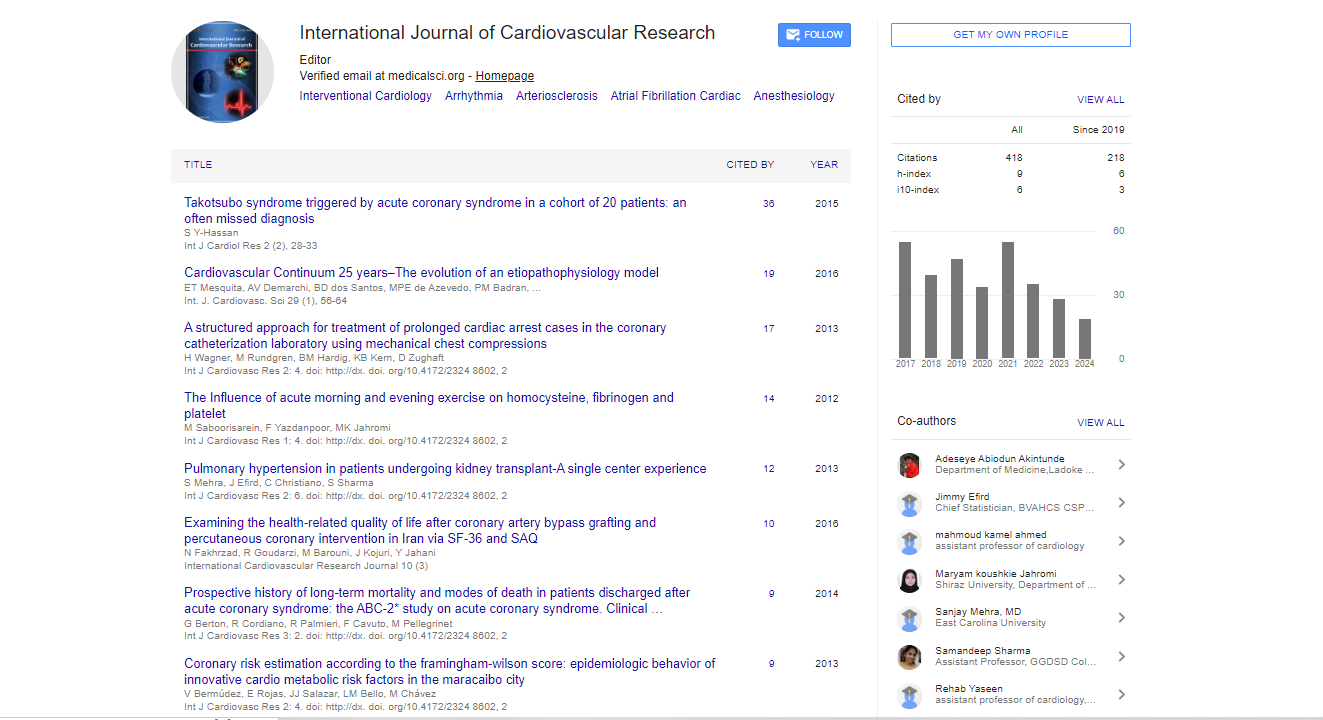Opinion Article, Int J Cardiovasc Res Vol: 12 Issue: 6
An Overview on Heart Transplantation and its Operating Difficulties
François Dubo*
1Department of Cardiovascular Medicine, Université de France, Paris, France
*Corresponding Author: François Dubo,
Department of Cardiovascular Medicine,
Université de France, Paris, France
E-mail: frandub@cardioresearch.fr
Received date: 27 November, 2023, Manuscript No. ICRJ-23-123653;
Editor assigned date: 29 November, 2023, PreQC No. ICRJ-23-123653 (PQ);
Reviewed date: 14 December, 2023, QC No.ICRJ-23-123653;
Revised date: 21 December, 2023, Manuscript No.ICRJ-23-123653 (R);
Published date: 28 December, 2023, DOI: 10.4172/2324-8602.1000533
Citation: Dubo F (2023) An Overview on Heart Transplantation and its Operating Difficulties Int J Cardiol Res 12:6.
Description
Heart transplantation stands as a testament to the remarkable achievements in medical science, offering a second chance at life to individuals with end-stage heart failure. The roots of heart transplantation trace back to the midcentury, with the work by surgeons like Norman Shumway and Christiaan Barnard. The first successful heart transplant took place in 1967 when Barnard transplanted a heart from a deceased donor into Louis Washkansky. Though the early years were marked by numerous challenges and limited success rates, ongoing research, and advancements in immunosuppressive therapies steadily improved outcomes. The heart transplantation process is an intricate dance involving coordination, precision, and collaboration among a diverse team of healthcare professionals. It begins with the identification of a suitable donor heart, often from deceased individual meeting specific criteria. The organ is carefully harvested, preserved, and transported to the recipient's hospital. Simultaneously, the recipient undergoes rigorous evaluation, including medical, psychological, and social assessments, to ensure suitability for the transplant. Surgical expertise comes to the forefront during the transplantation procedure itself. The recipient's failing heart is removed, and the donor heart is meticulously implanted, with intricate connections established between blood vessels and chambers. Post-surgery, the recipient enters a critical phase of recovery, closely monitored for signs of rejection, infection, and other complications.
One of the paramount challenges in heart transplantation lies in the delicate balance of suppressing the recipient's immune system to prevent rejection of the donor organ while avoiding overimmunosuppression, which may lead to infections and other complications. Advances in immunosuppressive medications, such as calcineurin inhibitors and antiproliferative agents, have significantly improved the success of heart transplantation by reducing rejection rates. Heart transplantation is not without challenges. The scarcity of donor organs remains a persistent issue, necessitating innovative strategies such as the use of Ventricular Assist Devices (VADs) as a bridge to transplantation. Additionally, the risk of rejection, infection, and the long-term effects of immunosuppression require ongoing vigilance. Recent breakthroughs in xenotransplantation, involving the transplantation of pig hearts into humans, offer a potential solution to the organ shortage. For recipients, a heart transplant is not just a medical procedure; it is a profound transformation. Many recipients describe the experience as receiving the "gift of life," emphasizing the emotional and psychological dimensions of the process. The restoration of normal cardiac function often results in improved quality of life, enhanced physical capabilities, and a renewed sense of hope and gratitude.
Conclusion
Heart transplantation stands at the intersection of medical innovation and compassionate care, offering a lifeline to those facing the dire consequences of end-stage heart failure. From its humble beginnings to ongoing breakthroughs, this medical marvel continues to evolve, reshaping the landscape of transplant medicine. As we celebrate the successes of heart transplantation, we must also confront the challenges that persist, working collaboratively to expand donor pools, refine immunosuppressive strategies, and push the boundaries of medical science to ensure that the symphony of life continues for those in need.
 Spanish
Spanish  Chinese
Chinese  Russian
Russian  German
German  French
French  Japanese
Japanese  Portuguese
Portuguese  Hindi
Hindi 



